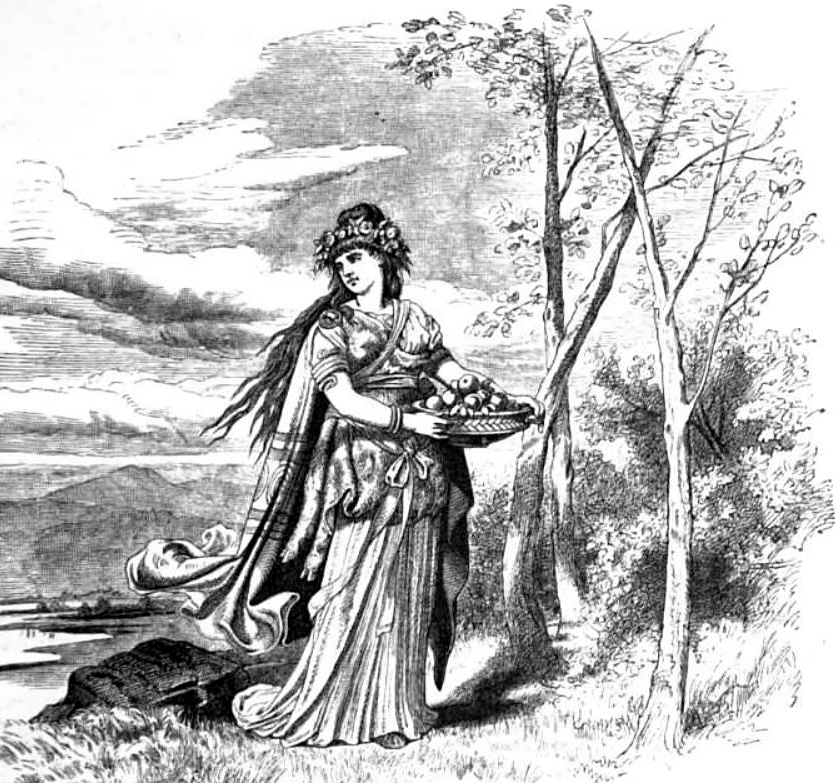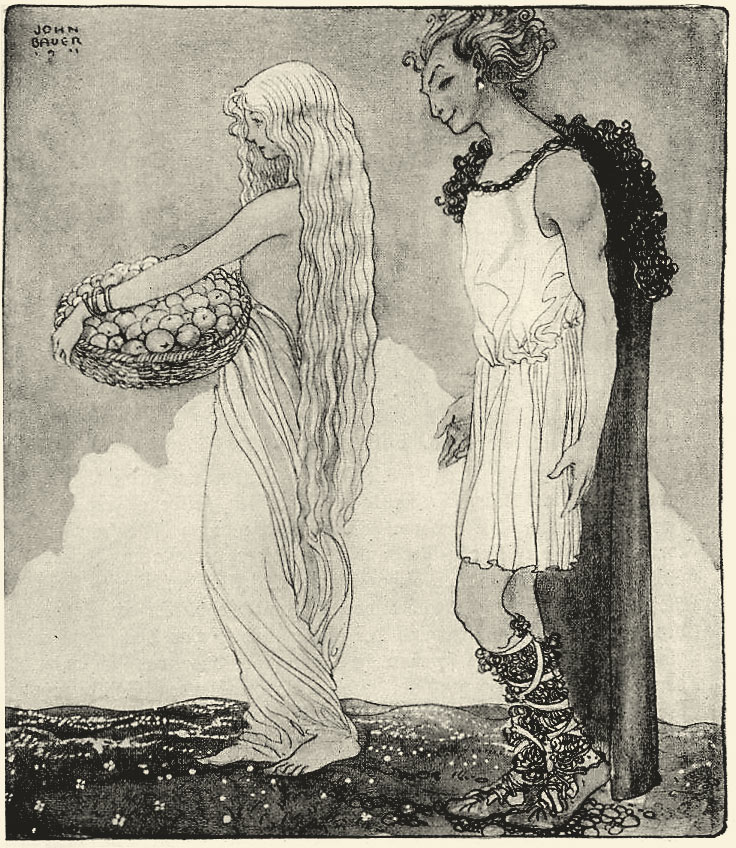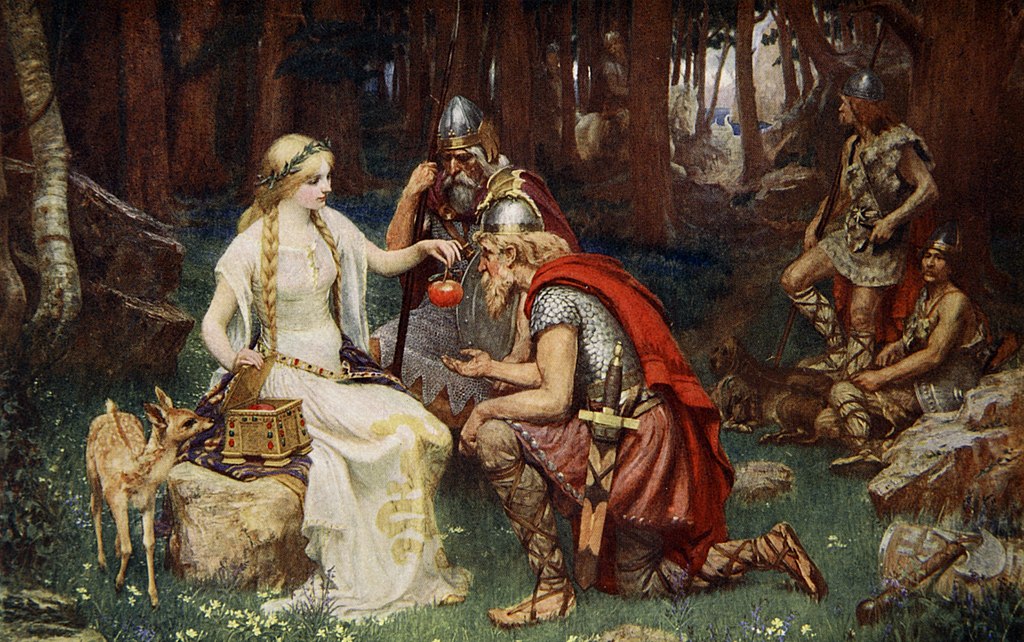The Norse goddess Idun (or Iðunn, Idunna) is the wife of Bragi, the god of poetry. She is the guardian of the magical apples that maintain the youth and vigor of the Æsir, the gods of the most important pantheon in Viking and Old Norse religion.
The Story of Idun
In Norse mythology, the goddess Idun (Old Norse: Iðunn, [ˈiðonː], pronunciation: ee-thoon, “th” as in “the” or “then”) is connected to apples and the youth they bring.
Idun has attestations in the Poetic Edda, a 13th-century compilation of ancient Norse poetry, and the Prose Edda by Snorri Sturluson, also from the 13th century. Both texts depict her as the wife of the skaldic god Bragi. The Prose Edda also describes her as a guardian of magic apples, which give eternal youthfulness.
Verse 17 of the Old Norse poem Lokasenna mentions how Loki accuses Idun of sleeping with her brother’s murderer (the identity of her brother and the killer are never revealed).
Skáldskaparmál, from the second part of the Prose Edda, mentions Idun in the first chapter as one of eight ásynjur (or goddesses) sitting on their thrones at a banquet in Asgard for Ægir.
There is no record of how she came to be the keeper of the apples.
Of What was Idun the Goddess?
Idun is familiar in Norse legend as the goddess of youth.
It is more accurate to say she was the keeper of the golden apples, which granted eternal youth to gods. This role was significant, considering Norse gods were mortal.
She carried the apples in a special ash wood casket called an eski.
Is Idun Æsir or Vanir?
Idun is Æsir.
There are few records of Idun in Norse literature or poetry before her appointment as the guardian of the magic apples. However, the Æsir and Vanir benefitted from the apples’ magical powers. In stanza 6 of the poem Hrafnagaldr Óðins, we learn something about the origins of Idun:
In the dales dwells, the prescient Dís, from Yggdrasil’sash sunk, of alfen race, Idun by name, the youngest of Ivaldi’s elder children.
Guardian’s Flame (Norse Mythology)
This information could mean she was initially from Halfeim, although her father was Ivaldi, so she was also a sister of the famous smiths, the Sons of Ivaldi, who were dwarfs.

Idun: Symbolism
Due to her safekeeping of the magical apples, she is most associated with youth and rejuvenation.
Idun’s Powers
Several theories involve Idun, including possible connections with fertility and longevity.
The Story of the Kidnapping of Idun
Where did Loki Take Idun, and Why
The Prose Edda tells a story of how the jötunn Þjazi kidnapped Idun.
Three Æsir gods, Odin, Loki, and Hoenir (son of Frigg), were boiling broth while on a journey together. They had come across some oxen and had slaughtered one for dinner. However, the meal they were preparing was not cooking in the pot, and every time they opened the lid, the meat was no more ready than it had been the last time they looked.
A colossal eagle was sitting in the branches of a nearby tree and told them its magic was why the meat wasn’t cooking, and if they let it have some, the rest of the broth would soon be ready.
It is I who by my magic prevent your catch from cooking. But if you will give me my fill of the meat, then I shall release the remainder from my spell.
The kidnapping of Idun – Berloga Workshop
The Jötunn Þjazi
The eagle swooped down and ate his fill of the ox. This act enraged the trickster god Loki, who attacked the eagle with a branch. The eagle caught the bough, dragged Loki into the air, and then along the ground. Loki implored the eagle, who was really the shapeshifting jötunn Þjazi, to release him. Þjazi agreed to this on one condition: that Loki brought him Idun and her apples of eternal youth.
After returning to Asgard, Loki sought out Idun and beguiled her with tales about a forest that contained more powerful apples than those she guarded. He convinced her to take the apples she protected with her so she could compare them to the ones he had mentioned to her.
Þjazi, still in the guise of an eagle, swept her up in his talons and carried her away to his castle in Þrymheimr (Thunderhome). Without the apples to sustain them, the people of Asgard and Vanaheim began to age.
The Skáldskaparmál describes how “the Æsir became straitened at the disappearance of Idun, and speedily they became hoary and old.”
They held a meeting to discuss Idun’s disappearance and realized the last sighting of her was leaving the city with Loki. Loki was summoned and admitted what he had done after Thor had threatened him with death and torture. He promised to make amends and rescue Idun if Freya (or Freyja) would let him use her falcon disguise.
Transformed Into a Nut
Loki’s disguise allowed him to enter Jotunnheim undetected and approach the castle, where he spied Idun walking the ramparts with her ash casket full of apples. Þjazi was out at sea in his boat, so Loki transformed Iðunn into a nut and gathered her in his claws to fly back to Asgard.
When Þjazi realized what had happened, he took the form of an eagle and flew swiftly after Loki and Idun. The people of Asgard could see the chase between the two as they approached the city and piled up mounds of wood shavings to set alight after Loki had passed. The giant eagle flew straight into the fire and was consumed. The people of Asgard slew him as he plummeted to the ground. The Skáldskaparmál tells how “this killing is greatly renowned.”
There is another terrific tale of how the giant’s daughter Skaði traveled to Asgard to seek revenge for the killing of her father.

Idun in Art and History
English folklorist Hilda Roderick Ellis Davidson has described how apples connect to Germanic pagan religion. She writes about how buckets of apples were discovered in a 9th-century burial site in Norway and how fruit and nuts (see the story of Idun and her abduction) were present in Germanic graves.
Due to Idun possibly meaning “forever young,” Professor Emeritus of Old Norse John Lindow (born 1946) suggested Idun could have provided eternal youthfulness to the gods without the apples.
He offers further evidence by stating that Haustlöng (a 10th-century skaldic poem by Norwegian Þjóðólfr of Hvinir) refers to Idun as understanding “the eternal life of the Æsir and does not mention apples.” Lindow believes Þjazi’s abduction of Idun to be “one of the most dangerous moments” for the gods, as it would reverse the general movement of female jötnar to the gods.
- Nils Blommér (1816-1853) painted a famous portrait of Idun and Bragi in 1846.
- John Bauer (1882-1918), a Swedish painter and illustrator, produced a painting of Idun and Loki in 1911.
- J Doyle Penrose (1862-1932) was an Irish painter who painted Idun and the Apples in 1890.

